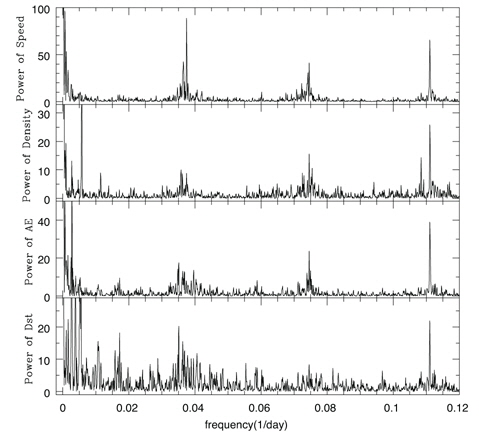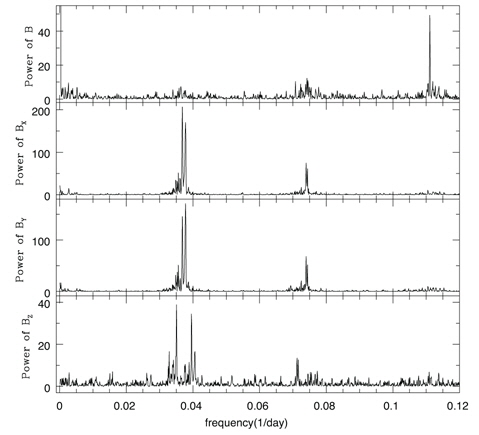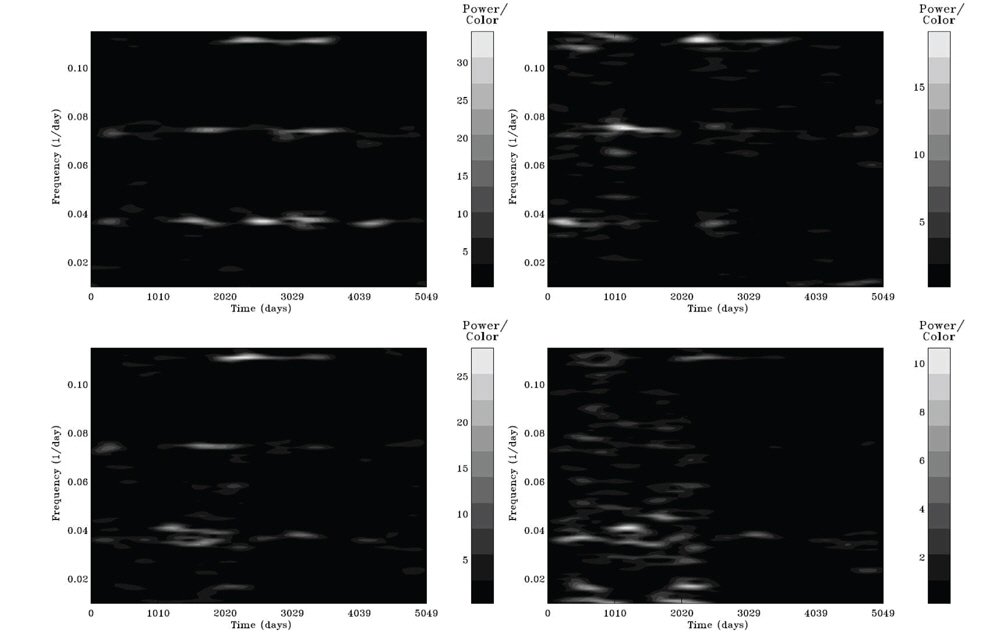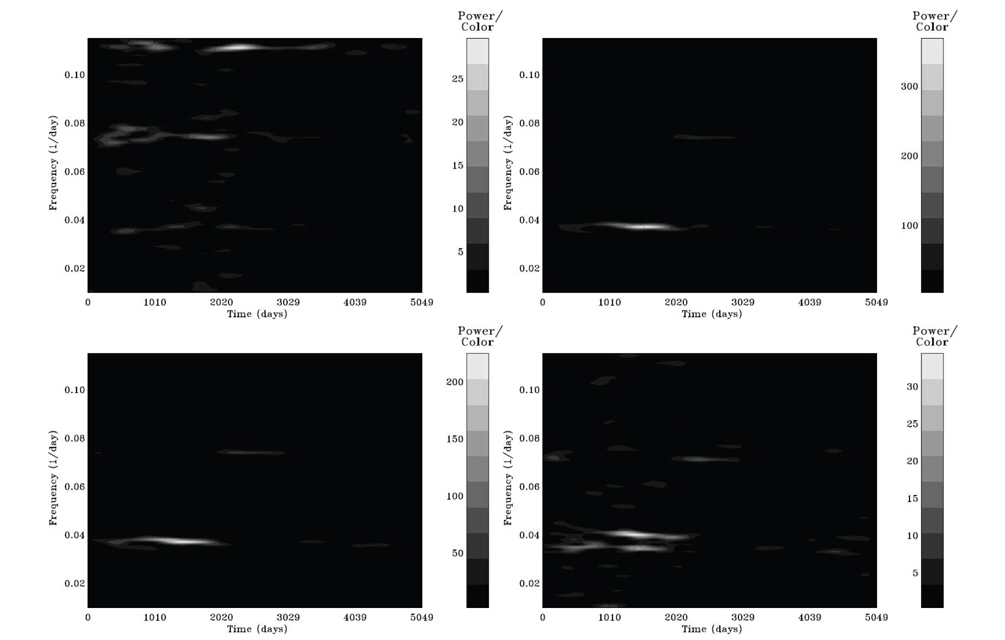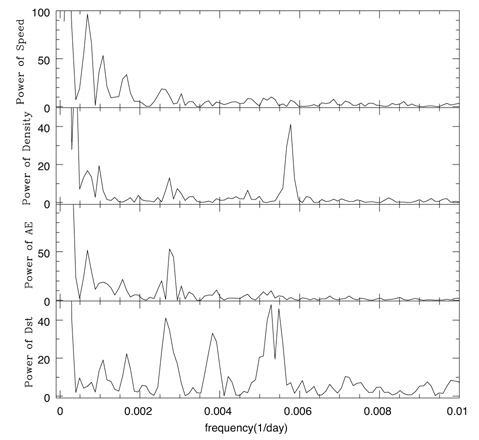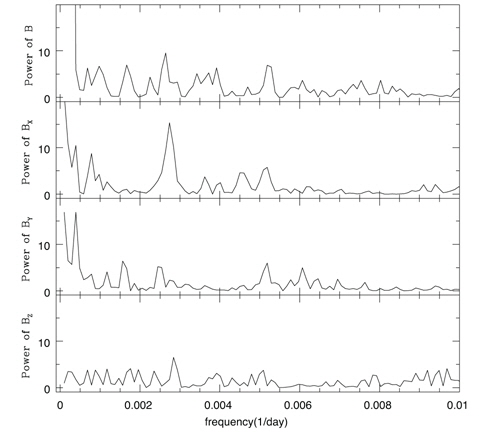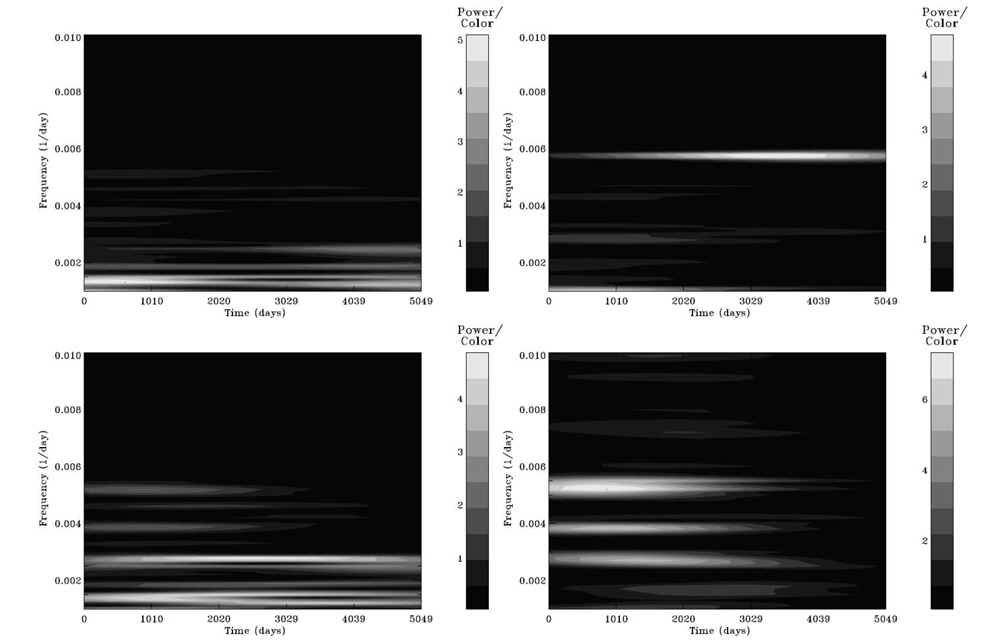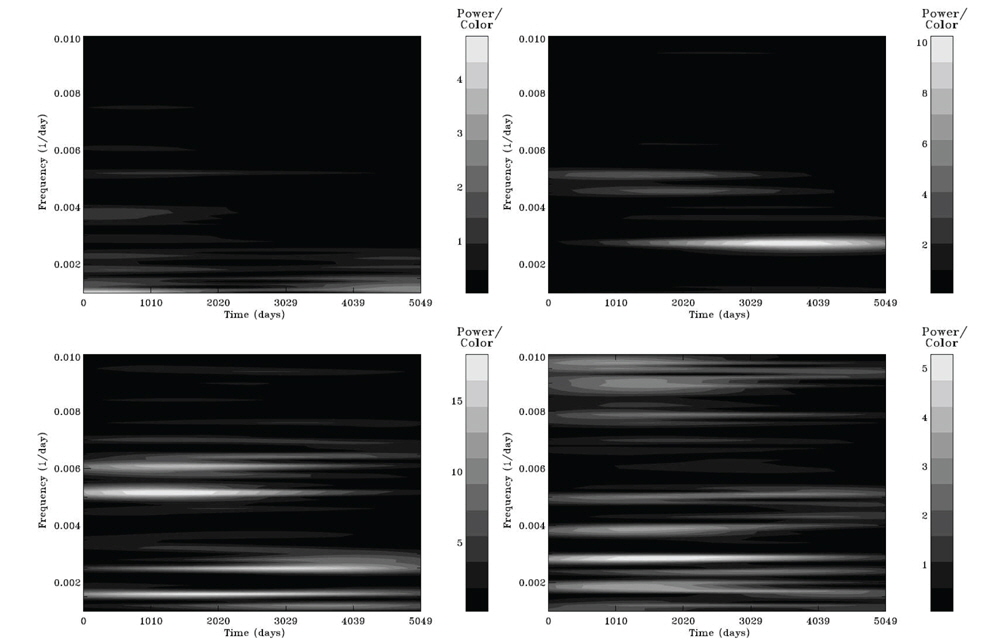



The Sun is a variable star with periods ranging from minutes to years. In particular, the variability in its magnetic field strength affects the interplanetary space and in turn the Earth’s electromagnetical environment (Kane 1986, Prestes et al. 2006). To identify actual mechanisms and processes for the observed variation in geomagnetic activity, the 11- year solar cycle and associated variabilities have been actively studied in the last decades. From harmonic analysis of variations of key parameters in geomagnetic activity, such as, the proton number density and bulk speed of solar wind, the interplanetary magnetic field strength, the disturbance storm time index (Dst index), the Auroral Electrojet index (AE index), periodicities of ~ 11 years, ~ 5.3 years, ~ 3.5 years, ~ 1.9 years are found being meaningful (Kane 1997, Clúa de Gonzalez et al. 2001, Kane 2005, De Artigas et al. 2006). Those periodicities obviously correspond to the main solar cycle and its overtones. In addition, the annual variation in the weak-to-moderate categories of storm intensity has been found in the Earth’s neighborhood, which is due to the Earth’s orbital revolution. The annual geomagnetic activity distribution is characterized with maxima around the equinoxes and minima near the solstices. The cause of this seasonal variation is still a matter of debate but may be attributed to one or more of the three models known respectively as the equinoctial hypothesis, the axial hypothesis and Russell-McPherron mechanisms (Russell & McPherron 1973, Clúa de Gonzalez et al. 1993). Further studies show, besides, that the annual distribution of magnetically-disturbed days is more complex when events with high levels of storm intensity are considered. That is, the presence of an anomalous peak in July for the monthly number of days with value of Ap > 200 nT or Dst< -180 nT is reported (Clúa de Gonzalez et al. 2002). This occurrence seems to be common along the 12 solar cycles covered by these indices.
In these parameters mentioned above, the solar rotational periodicity of ~ 27 days and its subharmonics with shorter periods have been revealed (Mursula & Zieger 1996, Prabhakaran Nayar et al. 2001, Mendoza et al. 2006, Charan Dwivedi et al. 2009, Emery et al. 2011). The power spectra of Galactic cosmic ray (GCR) intensity during solar cycle 23 have also been analyzed (Singh et al. 2012). They have too shown the existence of a variety of prominent short- and mid-term periodicities of ~ 27 days, ~ 14 days, and ~ 9 days as well as annual, semi-annual and tri-annual variations of ~ 200 days. Furthermore, studies have discovered a strong 1.3-year variation in solar wind speed and geomagnetic activities, which is expected to be due to the evolution of coronal holes (Richardson et al. 1994, Mursula & Zieger 2000, Obridko & Shelting 2007, Ruzmaikin et al. 2008, Cho et al. 2014). Several studies are devoted to oscillations with a period of 1.3 years revealed at the bottom of the solar convection zone. Komm et al. (2003) and Howe et al. (2000) have found out that the 1.3-year periodicity at the base of the convection zone is most pronounced in the solar rotation rate at the equator of the tachocline. In recent years, nonetheless, the oscillation periods of 1.3 years in helioseismic measurements have not been as clear as earlier (Komm et al. 2006).
The aim of this study is twofold. Firstly, following variations of the power over the time, we associate modes with periodicities of ~ a month seen in signals observed in the interplanetary space and in the Earth’s magnetosphere. If the power of two different signals shows uncoupled temporal behaviors over the time, even though they show a significant peak at the same frequency in the power spectrum, they can be possibly argued that they are causally unrelated. Thus, it is insufficient searching for reported periodicities in order to causally correlate geomagnetic activity parameters, rather requires examining the temporal features of the power. In this present study, we focus on short periodicities of a factor of a month close to the solar rotational period. We are to attempt to obtain information on the temporal behavior of the power in an oscillatory signal by employing the time/frequency analysis. The time/ frequency analysis, for instance, the wavelet transform, is able to give variations of power or frequency of a mode with time. This analyzing technique is used in many fields of physics and engineering, such as, acoustics, geophysics, helioseismology, image processing (Park & Chang 2013). Secondly, we attempt to search for any signatures of influence on the space environment near the Earth by inner planets revolving around the Sun (see, Kim & Chang 2014). Supposed that the inner planets make its shadow up to the Earth’s orbit at 1 AU from the Sun and disturb the Earth’s space environment, there must be a periodic perturbative signal in geomagnetic activity data corresponding to the synodic period of inner planets. We thus attempt to find out a possible evidence of such a shadow by looking for consistent signals in the power spectra that can be ascribed to the passage of the shadow.
This paper is organized as follows. We begin with brief descriptions of data analyzed for the present paper in Section 2. We present and discuss results of Lomb-Scargle analysis of geomagnetic activity indices in Section 3. Results of the time/frequency analysis are subsequently presented and discussed in Section 4. We discuss a possibility of shadowing of inner planets to the Earth’s space environment in Section 5. Finally, we summarize in Section 6.
For the present analysis, firstly, we have used the mean daily velocity of the solar wind during the period from 1999 to 2012, which is obtained by the Solar Wind Electron, Proton, and Alpha Monitor (SWEPAM) on the Advanced Composition Explorer (ACE) spacecraft. We have also used the number density of protons (np in # cm-3) in the solar wind during the same period. The proton density is observed by the same instrument on the ACE spacecraft. We have taken both data sets from the ACE Science Center website
3. LOMB-SCARGLE PERIODOGRAMS OF GEOMAGNETIC ACTIVITY INDICES
In Fig. 1, we show Lomb-Scargle periodograms of the velocity of the solar wind, the number density of protons in the solar wind, the AE index, the Dst index as a function of frequency in units of (), from top to bottom, respectively. Time series of data is taken during the period from 1999 to 2012. The power shown here is in an arbitrary unit. The periodogram analysis method developed by Lomb and Scargle is particularly appropriate for the analysis of unevenly sampled data (Cho & Chang 2011). This analysis method is basically same as Fourier analysis and sine curve fitting analysis. One of main advantages of this method is that the significance of a peak in the periodogram can be easily estimated, with a so-called false alarm probability. In plots, most conspicuous peaks in common are at the frequency of ~ 0.037 , ~ 0.074 , ~ 0.111 , when ignoring peaks whose frequency is less than ~ 0.01 , which we will come back to discuss later on in Section 5. They are the fundamental mode and its overtones, corresponding to periodicities of ~ 27 days, ~ 13.5 days, ~ 9 days. We note as other reports point out that the fundamental frequency is due to the solar rotation period. One might note that there is a barely recognizable peak at ~ 0.017 which is a half of ~ 0.037 .
In Fig. 2, we show Lomb-Scargle periodograms of magnitudes in the interplanetary magnetic field,
4. TIME/FREQUENCY ANALYSIS OF GEOMAGNETIC ACTIVITY INDICES
Compared to the Fourier transform, the Gabor transform
where
where
In Fig. 3, we show results from the wavelet transform analysis of the data. The horizontal axis represents time in day counting from the beginning of the data set, and the vertical axis the cyclic frequency in . The power is shown in gray scale, which is scaled by the mean value of the noise so that the signal-to-noise ratio can be assessed. In the top panels, results of the velocity of the solar wind and the number density of protons are shown from left to right. In the bottom panels, we show results of the AE index and the Dst index from left to right. As seen in Fig. 1, several high power peaks appear at ~ 0.037 , ~ 0.074 , ~ 0.111 , whose periods correspond to ~ 27 days, ~ 13.5 days, ~ 9 days, respectively. For the mode with the frequency of ~ 0.037 , temporal behaviors are akin, except the case of the proton density in the solar wind. That is, power of the proton density at this frequency appears to be very weak in time at about 1500, 3230, 4040 days, compared with results of others. In terms of the mode physics, this mode is likely to be excited by a somewhat different way. For the mode with the frequency of ~ 0.074 , while temporal behaviors of the solar wind velocity and the AE index are consistent, those of the proton density and the Dst index look different. Specially, this particular mode disappears in the case of the Dst index after 2000 days in time. On the other hand, for the mode with the frequency of ~ 0.111 , temporal behaviors of 4 parameters apparently coincide quite well.
In Fig. 4, we show results from the wavelet transform analysis of the interplanetary magnetic field strength. The horizontal axis represents time in day counting from the beginning of the data set, and the vertical axis the cyclic frequency in . The power is shown in gray scale, which is scaled by the mean value of the noise. In the top panels, results of the mean magnetic field strength(
5. SIGNATURE OF PLANETARY SHADOW
Here, we are particularly interested in the power spectrum of the frequency range where a recurrent perturbative signal in geomagnetic activity data due to the inner planets revolving around the Sun can be revealed. We zoom in the power spectrum to the frequency range including frequencies that correspond to the synodic and sidereal periods of inner planets, Mercury and Venus. By doing so, we attempt to search for any signatures of influence on the space environment near the Earth by inner planets revolving around the Sun.
In Figs. 5 and 6, we show Lomb-Scargle periodograms of the velocity of the solar wind, the number density of protons in the solar wind, the AE index, the Dst index, and those of
The sidereal periods of Mercury and Venus are 87.97 days and 224.70 days, respectively. The synodic periods of Mercury and Venus are 115.88 days and 583.92 days, respectively. Corresponding frequencies are ~ 0.0017 , ~ 0.0044 , ~ 0.0086 , ~ 0.0114 . Noticeable peaks do not emerge at those frequencies in power spectra shown in Figs. 5 and 6. There seems a vague hint that some peaks appear at ~ 0.0017 in the power spectra of the solar wind velocity, the Dst index,
Solar variability is a major cause of geomagnetic disturbances. Common periodicities in the solar activity and geomagnetic activity indices are widely known. However, it is insufficient to search for common peaks with similar periodicity in the simple-minded power spectrum based on the Fourier transform in order to correlate causally geomagnetic activity parameters. In this study we attempt to associate modes with periodicities less than one month by comparing temporal behaviors of the power of parameters in geomagnetic activity. As a result of the wavelet transform analysis we are able to obtain information on the temporal behavior of the power in the velocity of the solar wind, the number density of protons in the solar wind, the AE index, the Dst index, the interplanetary magnetic field,
What we have found are as follows: (1) Parameters we have investigated show periodicities of ~ 27 days, ~ 13.5 days, ~ 9 days. They are the fundamental mode and its overtones due to the solar rotation. The annual variations have been mostly found as well in the Lomb- Scargle periodograms. (2) The peaks in the power spectrum of BZ appear to be split due to an unknown agent. The splitting is ~ 0.005 which corresponds to ~ a half year. We suspect that the monthly variation in the southward component of B due to the solar rotation seems somehow modulated. (3) For the mode with the frequency of ~ 0.037 , temporal behaviors of power in the solar wind velocity, the AE index and the Dst index seem alike, except that power of the proton density appears to be very weak at about 1500, 3230, 4040 days in time, compared with results of others. For the mode with the frequency of ~ 0.074 , while temporal behaviors of the solar wind velocity and the AE index seem consistent, those of the proton density and the Dst index look different. This particular mode interestingly disappears in the case of the Dst index after 2000 days. (4) As a result of the time/frequency analysis we have revealed that all the powers seen in the Lomb-Scargle power spectra of B, BX, BY, BZ are concentrated at ~ 1500 days in time and cannot be seen in the second half of the observing time. (5) Noticeable peaks do not emerge at those frequencies corresponding to the synodic and/or sidereal periods of Mercury and Venus. There seems a vague hint that a peak appear at ~ 0.0017 in the power spectra of the solar wind velocity, the Dst index, B, and BY . Temporal behaviors of the mode in the case of the solar wind velocity, the Dst index, B and BY seem totally uncorrelated. Hence, we conclude peaks at the frequency of ~ 0.0017 cannot be regarded as a signature of the shadow of the inner planets.
